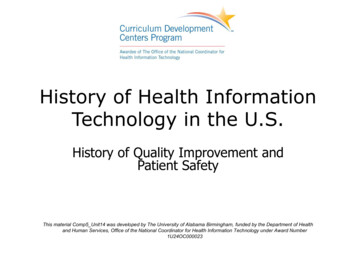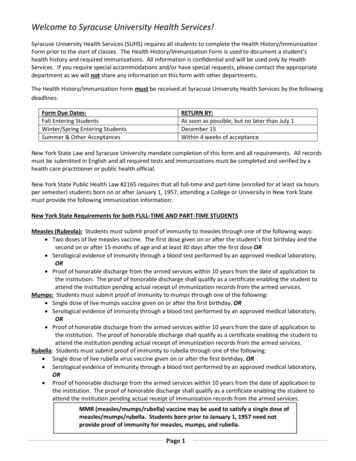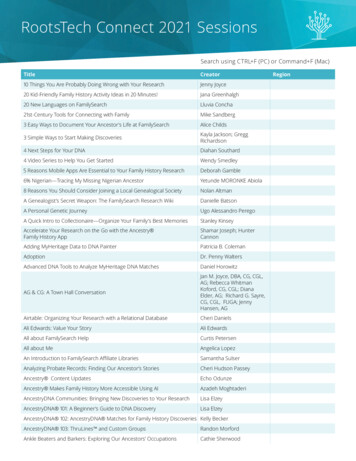
Transcription
History of Health InformationTechnology in the U.S.History of Quality Improvement andPatient SafetyThis material Comp5 Unit14 was developed by The University of Alabama Birmingham, funded by the Department of Healthand Human Services, Office of the National Coordinator for Health Information Technology under Award Number1U24OC000023
History of Quality Improvement andPatient SafetyLearning Objectives Describe conditions and notable publications concerningpatient safety and quality improvement from 1959 to thepresent Describe the background to the Institute of Medicinereports on patient safety Summarize the main findings from several Institute ofMedicine reports on quality, patient safety, and healthinformation technology (HIT) Describe various ways in which HIT has evolved toimprove quality or enhance patient safetyHealth IT Workforce CurriculumVersion 3.0/Spring 2012History of Health Information Technology in the U.S.History of Quality Improvement and Patient Safety2
Institute of Medicine Reports(1999)Health IT Workforce CurriculumVersion 3.0/Spring 2012History of Health Information Technology in the U.S.History of Quality Improvement and Patient Safety3
Institute of Medicine Reports Medical errors kill up to98,000 people annually Errors result from afaulty system notfaulty individuals(1999)Health IT Workforce CurriculumVersion 3.0/Spring 2012History of Health Information Technology in the U.S.History of Quality Improvement and Patient Safety4
Institute of Medicine Reports Quality of careincludes six maincomponents(2001)Health IT Workforce CurriculumVersion 3.0/Spring 2012History of Health Information Technology in the U.S.History of Quality Improvement and Patient Safety5
Institute of Medicine Reports Quality of careincludes six maincomponents Quality is suboptimal(2001)Health IT Workforce CurriculumVersion 3.0/Spring 2012 Health IT can helpimprove quality inmany waysHistory of Health Information Technology in the U.S.History of Quality Improvement and Patient Safety6
History of Patient Safety 460 BC Hippocrates, Greekphysician Widely consideredthe father ofwestern medicine Hippocratic oath:“First, do no harm”Source: (Wikimedia)Health IT Workforce CurriculumVersion 3.0/Spring 2012History of Health Information Technology in the U.S.History of Quality Improvement and Patient Safety7
History of Patient Safety 1959: “Diseases of Medical Progress: AStudy of Iatrogenic Disease” by Robert MoserHealth IT Workforce CurriculumVersion 3.0/Spring 2012History of Health Information Technology in the U.S.History of Quality Improvement and Patient Safety8
History of Patient Safety 1959: “Diseases of Medical Progress: AStudy of Iatrogenic Disease” by RobertMoser 1980s and 90s: Medical errors reported inthe popular pressHealth IT Workforce CurriculumVersion 3.0/Spring 2012History of Health Information Technology in the U.S.History of Quality Improvement and Patient Safety9
History of Patient Safety 1959: “Diseases of Medical Progress: AStudy of Iatrogenic Disease” by RobertMoser 1980s and 90s: Medical errors reported inthe popular press 1990: “Human Error” by James ReasonHealth IT Workforce CurriculumVersion 3.0/Spring 2012History of Health Information Technology in the U.S.History of Quality Improvement and Patient Safety10
History of Patient Safety 1991: Harvard Medical Practice StudiescompletedSources: (Brennan et al., 1991)(Leape et al., 1991)Health IT Workforce CurriculumVersion 3.0/Spring 2012History of Health Information Technology in the U.S.History of Quality Improvement and Patient Safety11
History of Patient Safety 1994: “Error in Medicine” by LucianLeape published in JAMAHealth IT Workforce CurriculumVersion 3.0/Spring 2012History of Health Information Technology in the U.S.History of Quality Improvement and Patient Safety12
History of Patient Safety 1994: “Error in Medicine” by Lucian Leapepublished in JAMA 1999/2001: IOM Reports releasedHealth IT Workforce CurriculumVersion 3.0/Spring 2012History of Health Information Technology in the U.S.History of Quality Improvement and Patient Safety13
History of Patient Safety 1994: “Error in Medicine” by Lucian Leapepublished in JAMA 1999/2001: IOM Reports released 2000: Leapfrog Group launchedHealth IT Workforce CurriculumVersion 3.0/Spring 2012History of Health Information Technology in the U.S.History of Quality Improvement and Patient Safety14
History of Patient Safety & Quality 2001: Agency for Healthcare Research andQuality (AHRQ) reorganized by US CongressHealth IT Workforce CurriculumVersion 3.0/Spring 2012History of Health Information Technology in the U.S.History of Quality Improvement and Patient Safety15
History of Patient Safety & Quality 2001: Agency for Healthcare Research andQuality (AHRQ) reorganized by US Congress 2002: Joint Commission released “NationalPatient Safety Goals”Health IT Workforce CurriculumVersion 3.0/Spring 2012History of Health Information Technology in the U.S.History of Quality Improvement and Patient Safety16
History of Patient Safety & Quality 2001: Agency for Healthcare Research andQuality (AHRQ) reorganized by US Congress 2002: Joint Commission released “NationalPatient Safety Goals” 2004: Office of the National Coordinator forHealth Information Technology establishedHealth IT Workforce CurriculumVersion 3.0/Spring 2012History of Health Information Technology in the U.S.History of Quality Improvement and Patient Safety17
History of Patient Safety & Quality 2009: The HITECH ActHealth IT Workforce CurriculumVersion 3.0/Spring 2012History of Health Information Technology in the U.S.History of Quality Improvement and Patient Safety18
History of Patient Safety & Quality 2009: The HITECH ActHealth IT Workforce CurriculumVersion 3.0/Spring 2012History of Health Information Technology in the U.S.History of Quality Improvement and Patient Safety19
History of Patient Safety & Quality 2009: The HITECH ActHealth IT Workforce CurriculumVersion 3.0/Spring 2012History of Health Information Technology in the U.S.History of Quality Improvement and Patient Safety20
IOM Report 2011 Potential of HIT to create harm Need for better information about thefailures of HIT systems Recommendation: Federal governmentshould create new agency to investigatesafety of health IT systemsHealth IT Workforce CurriculumVersion 3.0/Spring 2012History of Health Information Technology in the U.S.History of Quality Improvement and Patient Safety21
History of Quality Improvement andPatient SafetySummary History of Quality Improvement Patient Safety key milestonesHealth IT Workforce CurriculumVersion 3.0/Spring 2012History of Health Information Technology in the U.S.History of Quality Improvement and Patient Safety22
History of Quality Improvementand Patient SafetyReferencesReferences Brennan TA, Leape LL, Laird NM, et al. Incidence of adverse events and negligence in hospitalized patients.Results of the Harvard Medical Practice Studies I.N Eng J Med. 1991; 324(6):370-6. Institute of Medicine. Crossing the quality chasm: a new health system for the 21 st century. 2001. Institute of Medicine. Health IT and patient safety: building safer systems for better care. 2011. Institute of Medicine. To err is human: building a safer health system. 1999. Leape LL, Brennan TA, Laird NM et al. The nature of adverse events in hospitalized patients. Results of theHarvard Medical Practice Studies I.N Eng J Med. 1991; 324(6):377-84. Leape LL. Error in medicine. JAMA. 1994;272(23):1851-7. Moser R. Diseases of medical progress: a study of iatrogenic disease. Springfield: C.C. Thomas; 1959. Reason J. Human error. Cambridge: Cambridge University Press;1990.Health IT Workforce CurriculumVersion 3.0/Spring 2012History of Health Information Technology in the U.S.History of Quality Improvement and Patient Safety23
History of Quality Improvementand Patient SafetyReferencesImagesSlides 3,4: "To Err is Human" book cover, Kohn LT, Corrigan JM and Donaldson MS, (eds). "To Err Is Human: Building aSafer Health System" Committee on Quality of Health Care in America, Institute of Medicine, Washington DC:National Academies Press, 1999. Source Name: Image used with permission from National AcademiesPress.Slides 5,6: "Crossing Quality Chasm" book cover, Committee on Quality of Health Care in America, Institute ofMedicine. Crossing the Quality Chasm: A New Health System for the 21st Century, Washington, DC: NationalAcademy Press, 2001. Source Name: Image used with permission from National Academies Press.Slide 7: Bust of Hippocrates, Available from: http://en.wikipedia.org/wiki/File:Hippocrates rubens.jpg Source Name:Wikipedia Commons/Courtesy National Library of MedicineSlides 8, 11, 18: Clip Art, Available from: Microsoft clips online Source Name: Used with permission from MicrosoftHealth IT Workforce CurriculumVersion 3.0/Spring 2012History of Health Information Technology in the U.S.History of Quality Improvement and Patient Safety24
Slides 3,4: "To Err is Human" book cover, Kohn LT, Corrigan JM and Donaldson MS, (eds). "To Err Is Human: Building a Safer Health System" Committee on Quality of Health Care in America, Institute of Medicine, Washington DC: National Academies Press, 1999. Source Name: Image used with permission from National Academies Press.











